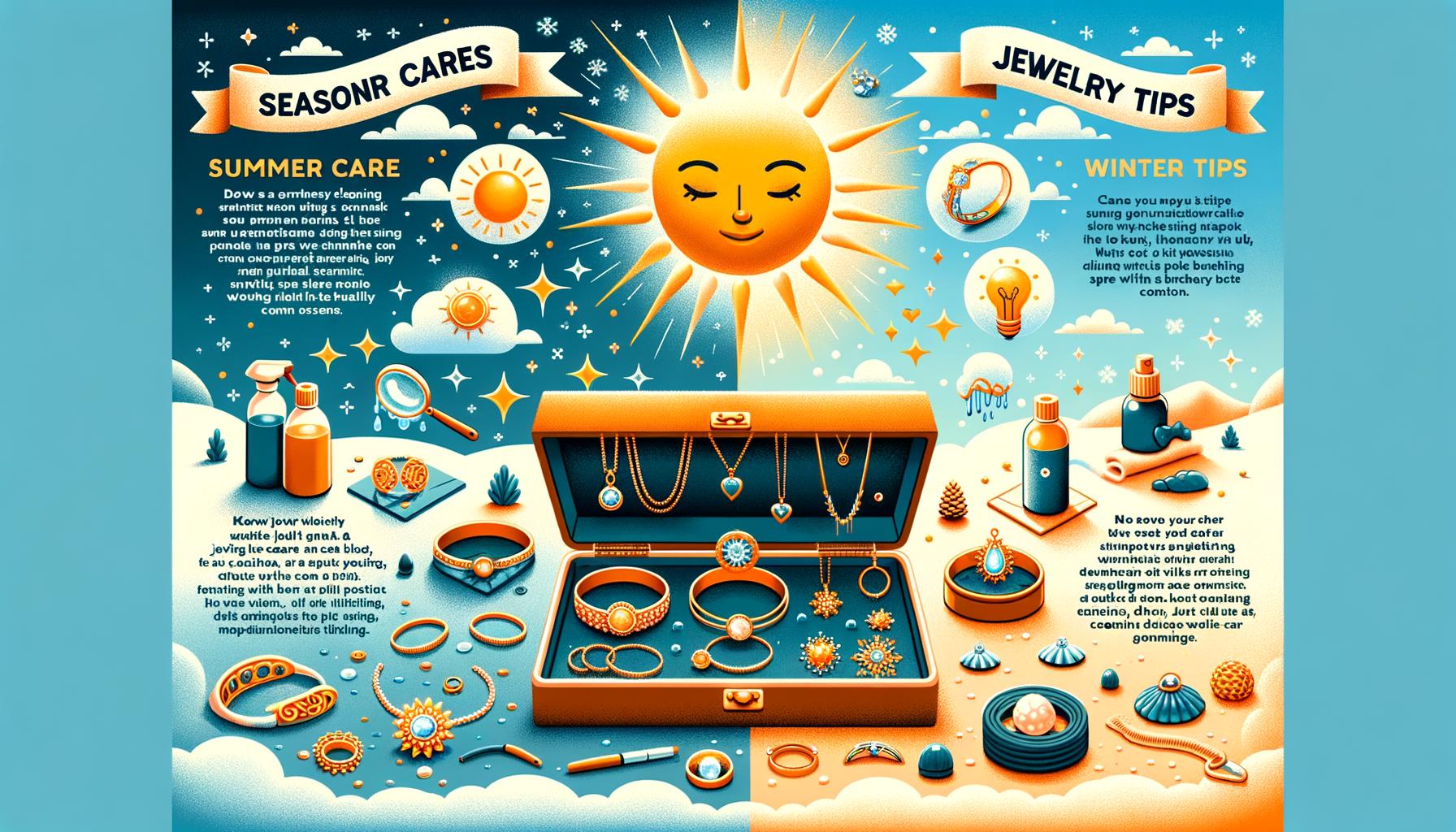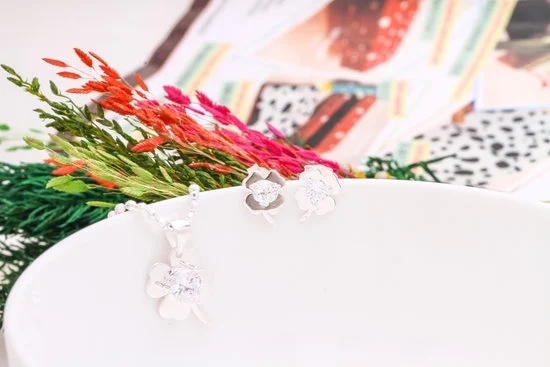Jewelry is more than just an accessory; it’s a cherished asset that often holds sentimental, historical, or monetary value. Given its importance, proper care is essential to maintain not only the appearance but also the longevity of these valuable pieces.
However, did you know that your jewelry collection needs different types of care depending on the season? Seasonal jewelry care tips for summer vs. winter are crucial because various environmental factors such as temperature fluctuations, humidity levels, and sunlight exposure can significantly impact the condition of your jewelry.
Summer and winter present unique challenges for maintaining your jewelry. In the sweltering heat of summer, high temperatures can warp metals while sweat and saltwater from ocean dips can tarnish finishes and loosen stones. Conversely, winter’s cold air and low humidity levels can make materials brittle, tarnishing metals quicker and affecting the integrity of stones. Understanding these seasonal effects is vital in preventing damage and ensuring that every piece remains as dazzling as the day you got it.
This guide aims to equip you with essential seasonal jewelry care tips tailored specifically for summer vs. winter. Whether it’s protecting your gold necklace from sun damage or ensuring your pearl earrings don’t dry out in cold weather, we’ll provide practical advice for each season. Our goal is to help you navigate through these changes seamlessly so your jewelry can continue to add sparkle to your life year-round.
The Impact of Seasonal Elements on Jewelry
Temperature Fluctuations
Temperature fluctuations between seasons can significantly impact the durability and appearance of your jewelry. During summer, extreme heat can cause certain metals to expand slightly. This expansion can weaken the settings that hold gemstones in place, increasing the risk of losing precious stones.
Conversely, the cold temperatures of winter cause metals to contract, which might make clasps and connections more brittle and prone to breakage. It’s crucial to account for these changes with appropriate seasonal jewelry care tips: summer vs. winter.
Humidity Levels
Humidity also plays a role in affecting different types of jewelry materials. In humid summer conditions, silver pieces are particularly susceptible to tarnishing due to increased moisture exposure.
On the other hand, winter’s low humidity levels can lead to dehydration and brittleness in organic materials like pearls or opals, making them more fragile and prone to cracking. Understanding how varying humidity impacts your jewelry helps you take preventive measures, such as using anti-tarnish strips during muggy days or keeping gemstones hydrated with proper storage solutions during dry spells.
Sunlight Exposure
Sunlight exposure is yet another critical element that can affect your cherished adornments throughout the year but takes a heightened toll during summer months when UV rays are strongest. Prolonged sun exposure can not only fade colored gemstones like amethysts or topaz but also degrade natural materials like ivory or coral over time.
Additionally, some metals may discolor when exposed excessively to bright sunlight. Employing preventive strategies such as storing items away from direct sunlight when not worn can mitigate potential damage effectively.
Understanding these seasonal elements provides a foundation for giving specialized care tailored to both summer and winter conditions, ensuring that your treasured pieces remain beautiful all year round.
Summer Jewelry Care Tips
Heat Considerations play a crucial role in summer jewelry care. High temperatures can cause metals to expand and contract, potentially leading to structural weaknesses over time. To mitigate this, it is advisable to store your jewelry in a cool, dry place away from direct sunlight.
Lined storage boxes or anti-tarnish bags are excellent choices as they offer added protection against heat and humidity. Additionally, if you’re planning to spend extended periods outdoors, consider removing your jewelry to prevent any damage from prolonged exposure.
Sweat and Saltwater are common culprits in the summertime that can wreak havoc on your prized pieces. Perspiration contains body oils, salts, and acids that can tarnish metals and dull gemstones.
Likewise, saltwater from the ocean can corrode certain materials such as sterling silver and even some less durable gemstones. It’s essential to rinse off your jewelry with fresh water after swimming in the sea and wipe them down with a soft cloth after any strenuous activity that causes heavy sweating.
Proper Storage during summer months cannot be overstated. When you’re not wearing your jewelry, storing it correctly will significantly reduce the risk of damage from seasonal elements. Avoid leaving pieces in hot cars or near windows where they may be exposed to direct sunlight for extended periods. Instead, opt for a dedicated jewelry box equipped with compartments to keep individual items separate and minimize scratching or tangling.
| Summer Care Tip | Details |
|---|---|
| Heat Considerations | Store in cool, dry places; use lined boxes or anti-tarnish bags. |
| Sweat & Saltwater | Rinse with fresh water after saltwater exposure; wipe down after sweating. |
| Proper Storage | Avoid direct sunlight; use compartmentalized storage boxes. |
These seasonal jewelry care tips: summer vs. winter highlight how different conditions-like temperature changes-can affect the longevity of your beloved accessories. Proper preventative measures ensure that your jewelry remains as stunning as ever throughout every season.
Special Care for Different Materials in Summer
During the summer months, jewelry made of different materials requires specific care routines to ensure longevity and maintain their aesthetic appeal. For metals like gold and silver, one of the key considerations is heat. High temperatures can cause these metals to expand slightly, which might loosen settings for stones or make clasps less secure.
As a preventive measure, it’s recommended to store your metal jewelry in a cool, dry place when not in use. Additionally, regular cleaning using a soft cloth can help remove any oils or perspiration that may accumulate due to higher temperatures.
Gemstones also demand special attention in the summertime. Diamonds, while known for their hardness, are still susceptible to damage if exposed to excessive heat or sudden temperature changes. Emeralds and opals are even more sensitive; these stones can crack or lose their luster under extreme conditions.
To mitigate this risk, keep gemstone jewelry away from direct sunlight whenever possible and avoid wearing them during activities that involve prolonged sun exposure or heat. Gentle cleaning with mild soap and water followed by careful drying can help maintain their shine without causing damage.
Organic materials such as pearls and coral are particularly vulnerable in hot weather. Pearls are composed of layers of calcium carbonate which can deteriorate with exposure to acids found in sweat and certain cosmetic products abundantly used during summer like sunscreen.
Coral too can become brittle if it loses moisture due to high temperatures. To preserve these delicate items, wipe them with a damp cloth after each wear to remove any residual chemicals, and store them in breathable fabric pouches rather than plastic bags that can trap moisture.
| Material Type | Summer Care Tips |
|---|---|
| Metals (Gold, Silver) | Store in a cool place; clean regularly with a soft cloth. |
| Gemstones (Diamonds, Emeralds) | Avoid direct sunlight; clean with mild soap and water. |
| Organic Materials (Pearls, Coral) | Wipe after each wear; store in breathable pouches. |
These seasonal jewelry care tips: summer vs winter demonstrate the importance of adapting your maintenance routines based on environmental conditions specific to each material type. By following these guidelines specifically tailored for summer care, you ensure your cherished pieces stay beautiful and enduring through warmer months.
Winter Jewelry Care Tips
Cold Weather Considerations
During the colder months, it’s crucial to protect your jewelry from extreme cold. Metals can contract and become more brittle in low temperatures, which increases the risk of breakage. If you know you’ll be outside for extended periods, consider leaving your most precious pieces at home or tucking them safely under layers of clothing. Rings are particularly vulnerable to temperature fluctuations; ensure they fit snugly to prevent accidental slips when your fingers shrink in the cold.
Dry Air and Its Effects
One often overlooked aspect of winter is the effect of dry indoor heat on your jewelry. Low humidity levels can affect different materials in unique ways, potentially leading to metal tarnish or gemstone brittleness. Silver and gold may lose their luster if exposed to dry conditions over long periods. To mitigate this, consider using a humidifier in rooms where you store your jewelry. This keeps the air balanced and helps maintain the integrity of both metals and stones.
Layering and Knits
Winter fashion often involves cozy sweaters and thick scarves, but these items can pose risks to your jewelry. Knit fabrics tend to snag easily on necklaces, bracelets, and rings, potentially causing material damage or even loss of delicate pieces like gemstones.
Opt for smooth clothing layers under chunky knits when planning to wear jewelry or choose pieces less likely to catch-such as short necklaces or stud earrings-to keep everything intact. Keep these seasonal jewelry care tips: summer vs. winter in mind to ensure that your treasures remain untarnished by seasonal changes.
Special Care for Different Materials in Winter
When it comes to the colder months, metals in your jewelry pieces require extra attention to maintain their allure. Gold, while resistant to tarnishing, can become brittle in extremely cold temperatures. To prevent this, keep your gold pieces in a padded jewelry box and avoid exposing them to drastic temperature changes.
Silver, on the other hand, tends to tarnish more quickly in low humidity typical of winter indoors due to heating systems. To mitigate this issue, store silver jewelry with anti-tarnish strips or in specially designed cloth bags.
For gemstone care during winter, remember that many stones are susceptible to damage from the dry air and cold weather. Diamonds may not show visible signs of distress but keeping them clean is essential as they can attract oils and dust more readily when conditions are dry. Use a gentle cleaner regularly and ensure they are stored separately to prevent scratching other softer gemstones like emeralds or rubies.
Additionally, some stones like opals contain water within their structure; thus, they can crack or craze if exposed to excessively dry conditions. It’s advisable to store them in slightly humid environments or with moisture-absorbing materials.
Organic materials such as pearls and corals can be particularly vulnerable during the winter months. Pearls prefer a bit of humidity as they can become dry and lose their luster when exposed to heated indoor air for prolonged periods.
To maintain their sheen, follow these seasonal jewelry care tips: summer vs. winter by storing pearls in a slightly damp cloth pouch or including a small dish of water nearby your storage area for added humidity balance. Similarly, coral is also at risk of becoming brittle under low-humidity conditions; hence wrapping coral pieces in soft cloth and placing them away from heat sources will help retain their beauty through winter’s chill.
- Store gold jewelry in padded boxes away from extreme temperature changes.
- Use anti-tarnish strips for silver items.
- Keep diamonds clean with gentle cleaners; store separately from softer gemstones.
- Maintain slight humidity around pearls by using damp cloth pouches.
- Wrap coral pieces softly and keep away from direct heat sources.
By following these specialized care instructions tailored for winter’s unique challenges, you can ensure that each piece remains flawless no matter how harsh the season gets.
Year-Round Jewelry Care Essentials
Maintaining the beauty and integrity of your jewelry requires year-round diligence. Regular cleaning, proper storage, and routine inspections are crucial to keeping your pieces looking their best regardless of the season.
First and foremost, establishing a consistent cleaning routine can significantly prolong the life of your jewelry. This involves both DIY methods using mild soapy water for a gentle cleanse and occasional professional cleanings for more delicate or intricate pieces.
For instance, diamonds can benefit from an ultrasonic cleaner when handled by a jeweler, whereas pearls should strictly be wiped with a damp cloth, avoiding submersion in water. The key is to know which materials you’re dealing with and apply appropriate cleaning techniques tailored to each one.
When it comes to storage solutions:
- Utilize soft pouches or lined jewelry boxes to prevent scratches.
- Consider desiccant packets for moisture control, especially for metal pieces that may tarnish.
- Use individual compartments (or even cloth separators) to keep items from tangling or abrading against each other.
Lastly, regular inspection and maintenance ensure longevity and safety of your precious items. Checking for loose settings, chipped stones, or worn-out clasps can prevent loss or further damage. Professional jewelers often provide these services along with detailed polishing treatments that restore luster without compromising the integrity of the piece. These seasonal jewelry care tips: summer vs. winter can help maintain their sparkle throughout the year while mitigating seasonal wear-and-tear factors efficiently.
Quick Reference Guide
When it comes to maintaining the brilliance and integrity of your cherished jewelry, adapting your care routine to the changing seasons is essential. Understanding how different environments affect various materials can save you time, money, and heartbreak in the long run. To make life easier, here’s a quick reference guide tailored to offer seasonal jewelry care tips: summer vs. winter.
In summer, high temperatures and increased humidity levels are two significant factors to consider. Metals like gold and silver can react with sweat and saltwater, leading to tarnishing or discoloration. For instance, a simple rule of thumb is always to remove your jewelry before hitting the pool or beach. Given that perspiration is higher in warm weather, frequent but gentle cleaning routines become all the more critical-using mild soap and water can help keep your pieces looking pristine.
On the flip side, winter brings its unique set of challenges like dry air and freezing temperatures. Metals can become brittle in extreme cold conditions while gemstones may lose their luster if exposed repeatedly to low humidity environments.
Investing in a good-quality humidifier for your living space during winter months can mitigate some of these effects by retaining optimal moisture levels in the air. Additionally, be cautious when layering clothes; delicate chains or intricate designs might snag on thick knits or wool fabrics.
For both seasons, adequate storage solutions play an important role in safeguarding your collection from damage. In summer, opt for airtight containers with anti-tarnish strips to protect against humidity. Conversely, during winter months, it’s wise to use padded cases that provide insulation against cold temperatures while also preventing accidental scratches from heavier clothing layers. Structured bracelets or necklaces should lie flat to maintain their shapes regardless of the season.
Implementing these easy-to-follow yet vital adjustments ensures that each piece of jewelry continues to shine vividly throughout the year.
Conclusion
Proper jewelry care throughout the changing seasons is essential for maintaining the longevity and beauty of your cherished pieces. Whether it’s the scorching heat of summer or the frigid cold of winter, adapting your care routines can make a significant difference. Seasonal jewelry care tips: summer vs. winter highlight that both extremes necessitate specific strategies to protect against environmental stressors. Taking action now will help ensure that your collection remains as dazzling in the years to come.
Don’t hesitate to add these seasonal strategies into your routine and observe how much longer your favorite accessories maintain their original allure and integrity. Implementing these tips not only preserves their physical condition but also safeguards sentimental value and monetary worth.
We invite you to share how these seasonal jewelry care recommendations have worked for you, or if you have any additional advice, please leave a comment below. Engaging with a community can provide even more insights and collective wisdom to enrich our maintenance practices further.
Additional Resources
Taking proper care of your jewelry throughout the year is crucial in preserving its beauty and ensuring its longevity. As we have explored, different seasonal elements such as temperature fluctuations, humidity levels, and sunlight exposure can significantly impact your treasured pieces. By adapting your jewelry care routines to the varying demands of summer and winter, you not only protect your items from potential damage but also maintain their shine and integrity.
Incorporating seasonal jewelry care tips: summer vs. winter into your maintenance regimen will help address the unique challenges posed by each season. During summer, this might mean taking extra precautions to prevent sweat or saltwater from causing corrosion or cloudiness in metals and gemstones.
Conversely, in winter, you may need to safeguard against brittleness caused by dry air or avoid snags from layering clothes. Each material requires specific attention-from ensuring metals like gold and silver do not lose their luster to keeping organic materials like pearls hydrated even amidst harsh conditions.
Remember that year-round best practices play a vital role alongside these seasonal measures. Routine cleaning, proper storage solutions tailored to different environmental factors, and regular inspection and professional maintenance are all part of an effective strategy for maintaining your collection’s quality over time.
By implementing these guidelines, you’ll be well-equipped to ensure that every piece remains gorgeous regardless of what season it is while adding personal anecdotes or additional advice can enrich our community’s shared knowledge on this topic.
Frequently Asked Questions
What’s the Best Way to Take Care of My Jewelry?
The best way to take care of your jewelry is by treating each piece with gentleness and giving it the attention it deserves. Store your jewelry in a clean, dry place, preferably in a fabric-lined box or a pouch to prevent scratches and tangling. Avoid exposing your pieces to harsh chemicals, perfumes, or lotions that can tarnish or damage metals and gemstones.
Regular cleaning with appropriate methods such as using a soft cloth for polishing and mild soapy water for certain types of jewelry can maintain their shine and luster. Lastly, consider professional check-ups for valuable items to ensure settings remain secure.
What Jewelry Looks Best on Cool Summer?
Cool summer skin tones are enhanced by jewelry that complements their natural coloring, typically favoring hues like silver, white gold, and platinum. These metals highlight the undertones of cool-colored skin without overwhelming them.
Additionally, gemstones in colors like blue sapphires, emeralds, and amethysts work well as they provide striking contrasts while harmonizing with the overall cool palette. Pearl jewelry also tends to look elegant on someone with a cool summer complexion due to its subtle sheen and classic appeal.
What Jewelry Looks Best on Winter?
For those with winter color types, deep and vivid shades tend to complement their strong contrast between hair, eyes, and skin tone. Jewelry made from metals like silver or platinum provides a crisp finish that matches this distinctive seasonal look perfectly.
Gemstones such as rubies, sapphires, emeralds, black onyx, and diamonds bring out the richness of winter features due to their bold hues and striking clarity. These combinations add an elegant touch while enhancing the natural sharpness found within winter complexions.

Welcome to my jewelry blog! My name is Sarah and I am the owner of this blog.
I love making jewelry and sharing my creations with others.
So whether you’re someone who loves wearing jewelry yourself or simply enjoys learning about it, be sure to check out my blog for insightful posts on everything related to this exciting topic!





